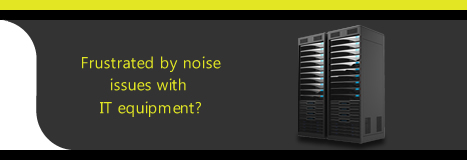How Do Quiet Racks Work?
This page introduces some of the main design features that must be considered when engineering a viable quiet rack, these include:
- Soundproofing techniques
- Air-flow for cooling
- Cable-management
What is a Quiet Rack?
A quiet rack is as soundproof 19" rackmount cabinet that has been specifically designed to reduce IT equipment noise from devices such as servers and switches. They also facilitate a constant level of air-flow to maintain a stable and safe operating temperature for installed equipment.
When using the term soundproof this can imply the total removal of noise, however this is not true of a quiet rack. The need for air-flow and cable access means it is not possible to seal and therefore engineer a totally silent rack.
A well designed quiet cabinet will provide sufficient cooling and cable access for the equipment it houses as well as effectively reduce noise levels.
Noise Reduction Techniques
When soundproofing a quiet rack cabinet, manufacturers will draw upon the following methods:
- Noise Reduction - by using an obstructing object, such as a baffle, sound paths are blocked.
- Noise Absorption - acoustic materials are used to trap and absorb sound waves. These are often manufactured to meet stringent international flammability standards, such as UL94, and therefore provide an additional level of protection/security.
- Active Noise Control (ANC) or Phase Cancellation - by reproducing sound waves with opposite polarity to the original sound the two waves effectively cancel each other out.
Air-flow/Cooling
Supplying sufficient air-flow to equipment housed inside a quiet-rack for cooling is critical to it operating safely within the manufacturers guidelines. Manufacturers have adopted two approaches to facilitate this, these are known as Passive and Active cooling.
Passive Cooling
Passive cooling is driven by the cooling fans within the installed equipment. This creates a low pressure area immediately behind the front door or doors and a high pressure area immediately in front of the rear door or doors. This causes cool air to be drawn into the front of the cabinet, warmed by the equipment, and then exhausted into the rear of the rack where it is expelled through the rear door or doors.
The cooling potential of a passive cabinet is going to be influenced, in part, by the cooling efficiency of the various types of equipment it houses and the way it is configured. This said, the amount of air-flow required is not exclusively governed by the equipment alone. Other factors must be considered, such as, equipment distribution, rack capacity and the immediate environment.
For passive cooling to be effective it is imperative that the installed equipment utilizes front to rear venting. Optional accessories are available to aid cooling for equipment with side to side venting.
Active Cooling
An Active cabinet relies upon fan assisted cooling to provide additional air-flow for higher thermal loads.
These fans are usually located in the roof compartment or at the rear of the cabinet where they help to expel warm air from behind the installed equipment. The number and type of fans can differ between manufacturers and even within the same rack range, so maximum thermal load levels can vary (your local accredited reseller partner will be able to assist you in calculating thermal load requirements and recommend which quiet cabinets are most suitable).
There is one exception to the definition of an Active cabinet and this is the 'AcoustiRACK ACTIVE' from Silentium. Although this cabinet uses fan assisted cooling, the term Active, in this case, refers to the incorporation of Active Noise Control technology.
Cable Entry & Cable Routing
The generous provision of cable access is of significant importance when one considers the number of networking cables and power lines that often need to be accommodated.
The solutions applied to cable entry are as numerous as there are quiet-rack ranges, so when choosing a soundproofed cabinet we suggest that you contemplate the following and discuss the best options with an approved Quiet-Rack reseller partner:
- Where will the cables be entering the rack – from the top, the bottom and the side or the rear?
- The total number of cables that need to be accommodated, bearing in mind potential scalability
- Internal cable management – would you benefit from additional internal width for orderly cable routing?











